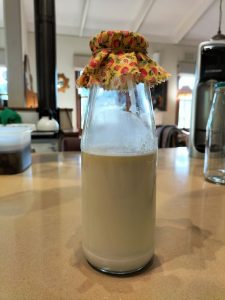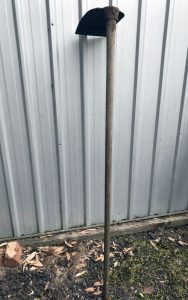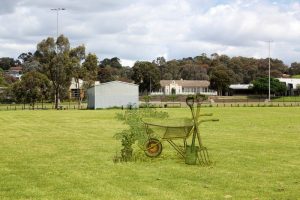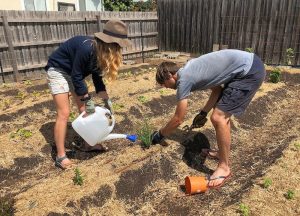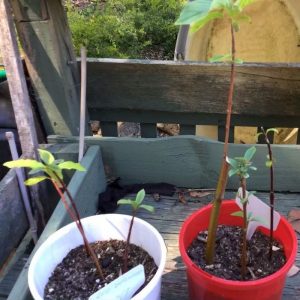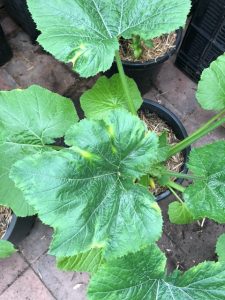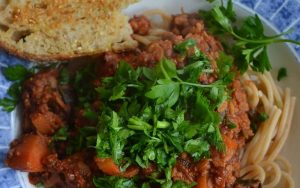 Thanks to all the people who have contributed to this week’s newsletter: Alex Salmon, Gina Wilson, Jaimie Sweetman, Jon Buttery, Lee Hirsh, Lynn Wallace, Megan Cassidy, Rebecca Gray, Robin Gale-Baker and Stuart Rodda.
Thanks to all the people who have contributed to this week’s newsletter: Alex Salmon, Gina Wilson, Jaimie Sweetman, Jon Buttery, Lee Hirsh, Lynn Wallace, Megan Cassidy, Rebecca Gray, Robin Gale-Baker and Stuart Rodda.
This is the last newsletter for 2021. Seasonal greetings to everyone. Don’t eat too much over the holiday period!
Regular activities over the rest of the calendar year
I think that all the events below are actually happening but I can’t guarantee it so you might want to check in advance if you are planning to go.
Farmers’ markets
Here are the differences from the usual monthly schedule:
- Abbotsford: there won’t be a market on 25th December.
- Alphington: there won’t be a market on 26th December but there will be an extra market on Thursday, 23rd December, 2-8pm.
- Coburg: there won’t be a market on 25th December but there will be an extra market on Wednesday, 22nd December, 2-8pm.
- Eltham: there will be an extra market on Thursday, 23rd December, 4-8pm at Eltham High School, 30-60 Withers Way. Also, the Boxing Day market will start at 9am rather than the usual 8am.
At the Eltham Farmers’ Market on Sunday, 12th December, North East Region Permaculture (NERP) will have an information stall.
Food swaps
Compared to the usual monthly schedule, there won’t be food swaps on either Boxing Day (Eltham) or (I presume) Christmas Day (Blackburn North, Brunswick East, Heathmont, Hurstbridge or Preston/Thornbury).
Community gardens
The website calendar includes all the usual monthly get togethers for those community gardens which have re-opened. It is difficult to know which of these get togethers will actually happen so, if you want to go to one of them, I suggest that you contact the relevant garden in advance.
Free community meals
As I said last week, it is difficult to know which of the community meals have actually re-started and the only ones that have notified me are Coburg (Food Not Bombs), Greensborough, Mill Park, Mitcham and Open Table (Fawkner and North Fitzroy).
Compared to the usual monthly schedule for these meals, (I presume) that there won’t be the normal meals on either Christmas Day (Fitzroy North and Mill Park) or Boxing Day (Mitcham), although there might well be other once-off meals that I don’t know about.
Robin discusses netting for success!
[This article by Robin Gale-Baker, from Sustainable Macleod, is one of a series of articles about growing techniques for fruit and vegetables.]
Purpose of netting
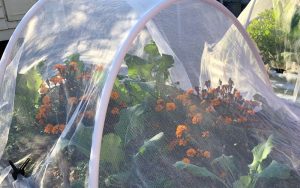 A major purpose of netting is to prevent both mammals (e.g. rats and possums) and birds from accessing your fruit and vegetables. Be aware, however, that rats can tear holes in a net if hungry enough.
A major purpose of netting is to prevent both mammals (e.g. rats and possums) and birds from accessing your fruit and vegetables. Be aware, however, that rats can tear holes in a net if hungry enough.
Netting is the most successful preventative for Queensland fruit fly in both fruit and vegetables and for this reason is an essential tool in the garden.
Netting is particularly valuable for brassica family plants (including cauliflower, cabbage, Brussel sprouts and broccoli) to deter white cabbage moth for solanaceae family plants (including tomato, eggplant, capsicum and chilli) to deter various caterpillars.
Choice of netting
Netting selection is a vital aspect of insect control in the fruit and veggie garden.
Appropriate mesh size will protect fruit and vegetables from a range of insects while inappropriate mesh size may actually increase the numbers of non-beneficial insects including aphids and thrips.
For all fruit and veggies, my suggestion is that you use white netting with mesh of 1x3mm or 2x2mm.
A smaller mesh size does not allow sufficient ventilation inside the netting, and creates a warm microclimate that is conducive to heavy breeding of certain bugs especially thrips and aphids. What’s more, such mesh is too fine for these bugs to exit and escape. If you wanted to breed these bugs, you would have created the perfect environment to do so!
I prefer the 2x2mm mesh because I can buy it off the roll at Bulleen Art and Garden. Buying off the roll allows me to determine the lengths that I need and it is also much wider than that purchased in packets. Net that is narrow is rarely useful (except perhaps for a low cloche) as it does not have sufficient margins to hang down the sides or for the edges to be weighted or covered.
Netting which is white in colour helps to prevent sunburn on produce.
Finally, cotton or cotton-based netting is preferable to synthetic netting as the latter heats up considerably more.
Timing of netting
The ideal time to net is just after pollination. Netting too early will exclude the pollinators that transfer pollen from flower to flower and will result in a lack of fruit. Netting too late, while better than nothing, is likely to have resulted in some damage to foliage, for example from sucking insects, which weakens the plant.
Placement of netting
Netting needs to be comprehensive. Any holes need to be sewn up and the edges need to be weighed down with weights or soil. Net over trees should either be weighted around the base or tied firmly to the trunk.
Rats can climb up netting so, in the case of wooden wicking beds, make sure that the netting is not left to drag on the ground and secured instead at the top edge of the bed. Corrugated beds are too slippery for rats to climb but, likewise, keep the net as high off the ground as possible.
Jaimie’s edible plant of the month – juneberry tree (Amelancheir arborea)
[Jaimie Sweetman is Head Gardener of the Edible Forest located on the Yarra Valley Estate in Dixons Creek. Tours of the Edible Forest, often led by Jaimie, take place on all days except Sundays – read more and book your place on a future tour.]
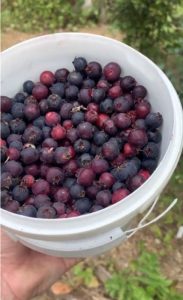
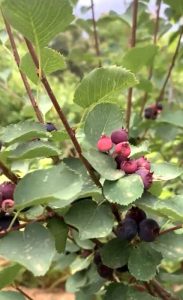 The juneberry tree is one of our favourites in the forest – a small tree that really gives!
The juneberry tree is one of our favourites in the forest – a small tree that really gives!
In autumn, it is a flush of red deciduous leaves, followed by cream flowers in spring. But the berries are the main stars! They ripen from pink to a deep purple and taste a little like bubble gum. Whilst they look a bit like blueberries, they are actually more closely related to apples (both being in the rose family – rosacea).
Coming from North America and sometimes called serviceberries or sugar plums, they are not often seen in Melbourne, nor are they easy to find here. If you do stumble upon one, it’s a great find! If not, then the one in our forest fruits through December and is worth the visit!
Another member of the Amelancheir genus is the saskatoon (Amelanchier alnifolia), which is smaller (only grows to shrub size) and much easier to find in Victoria (although still not common).
[Editor: the juneberry is so-called because the berries set in June. But that, of course, is in the Northern hemisphere and is the equivalent of December in Australia. So maybe we should be calling it the decemberberry.]
Red-veined sorrel (by Megan Cassidy)
[Megan, from Greensborough, is active within Sustainable Greensborough. As discussed on her website, she is a freelance copywriter.]
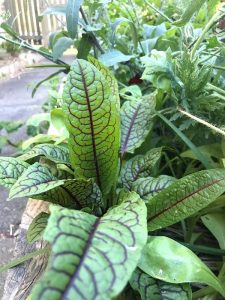 Red-veined sorrel (Rumex sanguineus) is also known as bloody dock.
Red-veined sorrel (Rumex sanguineus) is also known as bloody dock.
This is a little plant that has surprised me. I grew my red-veined sorrel from seed, which struck quite readily and grew into beautiful, resilient plants.
The look
The vibrant green leaves are relatively long and wide with a pointed end, a bit like a big feather, but it is the deep reddish-purplish veins that make it stand out in the garden and provide some highlights of colour.
The growth
Red-veined sorrel doesn’t get too big. I’ve found that it grows well in semi-shaded conditions, even under several other plants, as an understorey perennial plant. It also grows throughout winter, albeit a bit slower. This makes it a great addition to the food garden for the cooler months. I have around 10 plants dotted around my garden in various positions so that there are always a few young leaves ready for picking.
The taste
Red-veined sorrel has a slightly lemony taste, which makes it a bit different to other greens. It can be eaten raw in small amounts, and looks striking as a garnish in salads. The leaves can get bitter as they get bigger though, so leave those ones to catch the sun.
A warning
The leaves have a high oxalic acid content so don’t eat a whole bowl of them raw, and avoid if you have issues with kidney stones.
To mostly neutralise the oxalic acid, you can blanch in a pot of boiling water for a few minutes, like you do spinach or warrigal greens, drain (discarding the water completely), and add to a stir-fry, quiche or another dish.
If you have excess leaves, you can blanche and freeze for a quick addition to your meals whenever you need.
* * * * *
So, if you’re looking for something a bit different to increase your biodiversity, bring some colour to your garden and give you more ‘greens’ options year-round, red-veined sorrel might be for you.
Mattocks (by Stuart Rodda)
[This article by Stuart is one of a series of articles about garden tools. it is the last article about large hand tools.]
 A mattock is defined here as a digging tool with a heavy blade at approx. 90 degrees to the handle. Heavier than a garden hoe and similar to a pick but with a wider blade, a mattock is one of the most effective hand tools for digging into hard or rocky ground. It has stood the test of time, such as digging for gold during the gold rush or for digging into the subsoil to make a trench or plant a tree. One side of the head is the main blade while the other side can be in the shape of a pick or an axe.
A mattock is defined here as a digging tool with a heavy blade at approx. 90 degrees to the handle. Heavier than a garden hoe and similar to a pick but with a wider blade, a mattock is one of the most effective hand tools for digging into hard or rocky ground. It has stood the test of time, such as digging for gold during the gold rush or for digging into the subsoil to make a trench or plant a tree. One side of the head is the main blade while the other side can be in the shape of a pick or an axe.
Mattocks are usually used for breaking up, or moving, previously unworked ground. They are used with a full arm swinging action to make the most of their momentum as they hit the ground. Whilst some people use them for cutting through tree roots, I have found that a sharp axe is easier to use for that purpose because the axe blade is in line with the arc of your swinging blow rather than at 90 degrees to it. So, mattocks with an axe-like blade on the opposite side to the main blade allow you to tackle multiple needs with the one tool.
Mattocks are usually short handled because the head is too heavy to lift otherwise. Because they are used more to break the soil, rather than lifting up a clod, another tool such as a shovel is then used to move the broken ground.
Features to look for include: a thick blade around 10 to 12 cm wide at the tip, which is strong and made from steel which will hold a sharp edge; a strong handle; and an overall size/weight appropriate to your strength and the job. A sharpened blade edge gives good soil penetration but can be hazardous for feet or fingers. It is a good idea to wear safety glasses when using a mattock as stones, soil or bits of tree root can fly into your eyes.
Mattocks traditionally had wooden handles, which need to be made from a strong hardwood to withstand leverage. Fitting a mattock head securely to a wooden handle can be difficult because of the need for a precise taper of the wood, the constant loosening effect of pounding into hard soil or rock and the shrinkage of wood as it dries out. I have found that mattocks with a solid fibreglass handle are more durable and secure, although you do get a certain amount of jarring back through a fiberglass handle which can be minimised by wearing gloves.
Jon’s podcast of the week
While not about food, this was an interesting podcast about the Warrnambool Botanical Gardens. We can now go there and this podcast even contains a recommendation on where to have breakfast before the visit. It was lovely to hear about the thinking behind the gardens and also someone who welcomes visitors asking questions.
Do you know?
 How to get rid of sheep’s sorrel?
How to get rid of sheep’s sorrel?
Alex Salmon spends time working in a communal garden space in Burwood. Over the last few years, sheep’s sorrel (Rumex acetosella) has taken over several of the wicking beds. She has sifted through the soil with fork and hands to about 15cm deep, removing all pieces of root, but anything that escapes her soon flourishes. Someone else sprayed with Roundup but the plants soon grew back. In desperation, Alex is thinking about removing all the soil and either putting it carefully through a sieve to remove any root material or completely replacing it. Can anyone suggest an easier solution? Email me with your responses and I’ll pass them onto Alex.
What is this plant?
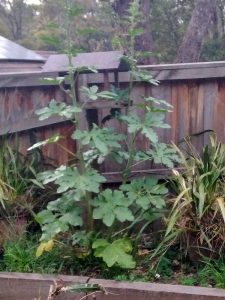 Gina Wilson has written in: “I have a ‘triffid’ in my backyard. I have no idea where it came from, as it is nowhere near the compost heap, but it is next to one of our bird feeding stations, so I am assuming it has been dropped by a bird. It appeared about July this year and seems to grow about two inches every night, as it has just about pushed the bird feeder over. It is now about 5 feet tall. There are no flowers or fruit of any kind, but there are buds that look like they might turn into flowers but they then just become leaves. Does anyone know what my plant is? Email me with your responses and I’ll pass them onto Gina.”
Gina Wilson has written in: “I have a ‘triffid’ in my backyard. I have no idea where it came from, as it is nowhere near the compost heap, but it is next to one of our bird feeding stations, so I am assuming it has been dropped by a bird. It appeared about July this year and seems to grow about two inches every night, as it has just about pushed the bird feeder over. It is now about 5 feet tall. There are no flowers or fruit of any kind, but there are buds that look like they might turn into flowers but they then just become leaves. Does anyone know what my plant is? Email me with your responses and I’ll pass them onto Gina.”
Do you have?
Rebecca Gray recently took advantage of Karen Olsen’s offer of milk kefir grains. Now she is after some water kefir grains. Can anyone help? Email me and I’ll put the two of you in contact.
More on mycorrhizal fungi
Following the discussions on mycorrhizal fungi in recent weeks, Lynn Wallace suggests that you read the recent article in the Guardian entitled A powerful and underappreciated ally in the climate crisis?.
Has Eltham become the gin capital of Australia?
In the 2021 Australian Distilled Spirits Awards, there appear to have been 6 gin awards, namely for: best Australian, best Victorian, London dry, navy, new world / contemporary and ‘other’. Of these 6, 3(!) were won by Eltham-based distilleries: Naught Distilling won both best Victorian and best new world / contemporary; and Imbue Distillery won the ‘other’ category (for their barrel-aged gin). Congratulations to Chris, Luke, Mel, Mick and Nikki!


Some interesting(?) permaculture sites
You may, or may not, be aware of (and may, or may not, care about) the current controversy regarding David Holmgren’s recent participation in one of the Melbourne protest marches holding a sign which included the word ‘permaculture’ in large letters. In any event, one of the unexpected, positive byproducts from the consequent discussions was that someone invited people to list their personal permaculture websites or Facebook pages. Here are some of the responses:
- Balcony permaculture (website).
- Loose parts press (Facebook).
- Science-based regenerative systems (website).
- Sel of the garden (website).
- The suburban permaculture garden (website).
Note that, if you want to find out more about the controversy, one place you could start is by joining the Evidence-based permaculture Facebook group.
My end of year report
As you know, the newsletter is a weekly production which is currently sent to around 3,500 people each week. The website comprises several thousand pages and is currently viewed by around 9,000 people each week. The two are closely intertwined, with any new articles on the website being summarised in the newsletter and with most of the material from the newsletters also being somewhere on the website. Both focus on the geographic area of ‘North East Melbourne’.
The newsletter
The traditional focus of the newsletter has been on advertising upcoming local events. In the first half of 2021, this is what the newsletter concentrated on, with hundreds of workshops, community garden get togethers, meals, food swaps and markets being listed in each newsletter.
In the second half of the year, however, Melbourne locked down again and there were very few face-to-face events (and not very many online events). Therefore, as in 2020, the newsletter had to partially re-invent itself as a more interactive publication where readers ask/answer questions about food-related matters, offer tips, provide recipes and write articles. There were also a number of photo competitions.
The website
The main purpose of the website is to be a source of information about local food organisations and activities, where local means ‘North East Melbourne’.
In total, around 330 local food organisations now have pages on the website, each of which has been developed in concert with the organisation, who have also approved the final presentation. These organisations are of various types including local food producers, local food outlets, community gardens, food swaps and local food justice organisations.
Establishing contact with, and pages for, the local food justice organisations has been a major theme of 2021, with the website now having pages on 7 food relief organisations, 3 neighbourhood houses which offer free food, 13 food-is-free initiatives and 13 community pantries. Go to the food justice section of the web site.
There are also now around 100 ‘growing guides’ and around 50 ‘eating guides’
Newsletter contributors
The quality and scope of both the newsletter and the website have been dramatically increased by the regular contributions of a number of people, including (but not limited to):
- Angelo Eliades, for his responses to various newsletter reader questions.
- Ann Stanley, for her garden and other write-ups (Covid interrupted).
- Bruno Tigani, for his responses to various newsletter reader questions.
- Jaimie Sweetman, for her monthly articles on unusual edible plants.
- Jian Liu, for her varied contributions.
- Jon Buttery, for his weekly links to interesting podcasts.
- Judy Vizzari, for her garden and other write-ups (Covid interrupted).
- Lucinda Flynn, for her wide variety of eating-related articles.
- Megan Goodman, for her monthly garden articles and associated recipes.
- Pam Jenkins, for her various contributions, including video growing guides.
- Robin Gale-Baker, for her monthly articles about growing veggies, growing fruit trees and various growing techniques.
- Stuart Rodda, for his articles on garden tools and other subjects.
- Vasundhara Kandpal, for her recipes.
My thanks to them all.
More generally, since the start of the pandemic, around 350(!) different people have contributed to the newsletter. Here’s the list:
|
Agnes Wilson Aimee Maxwell Alfred Zahra Alice Mathieu Alison Fraser Alison Raven Ally Price Angela Chung Angela Hewitt Angela Spencer Ann Stanley Aldona Kmiec Alison Fraser Alison Raven Ally Shepherd Amanda Coombes Amanda Healy Amy Thomas Amy Wong Angela Harridge Angelo Eliades Angie Kristens Angie O’Connor Anita Merson Anjana Mukherji Ann Hague Ann Stevens Anna Matilda Anna Rosa Pascuzzo Anna Sanders Anne Parbury Annelise Tedesco Annie Howard Archna Bhatt Astrid Judge Avril Clark Aziza de Fazio Bali Portman Barb Whiter Beck Holder Beata Clark Belinda Lock Belinda McPhee Berry McSherry Bev Middleton Bev Robertson Brendon Bolton Brent Collett Bronwen Whyatt Brooke Earl Bruce Plain Bruno Tigani Callie Lastdrager Cameron Cairns Carol Woolcock Carolyn Speed Cara Horner Carrie Newbold Cate Townsend Cath Lyons Catherine Knight Catherine Mortimer Cathy Romeo Cecilia Macaulay Chantelle Ladouceur Charles Dickerson Che Hall Chloe Cann Chloe Thomson Choon Yin Yeok Choy Lai Chris Kent Chris Chapple Chris Mills Chris Newman Chris Tankard Christine Kay Claire Smith Clare Quinlan Connie Curato Daisy Lio Dale Martin Dan Milne Dan Ross Dassana Darryl Wilson Dave Chambers |
David Hicks Deb Anscombe Deb Graham Deb Thomson Deborah Taylor Delldint Megan Fleming Dianne Parslow Dione Fisher Doris Glier Doris McAllister Dorothy Kwak Drew Barr Duang Tengtrirat Elaine Rust Elissa Hunter Elissa Oppenlander Elizabeth Doig Elle Lawrence Emily Alexandra Emma Tucker Emma Tymms Eric Nuccio Evan Gellert Farah Dawwas Fay Loveland Felicity Gordon Fiona Finch Fran Lennard Fuchsia Branwhite Gabrielle Callahan Gayle Parkes Gemma Elliott George Pergaminelis Georgia Tracy Georgie Nathan Georgina Aquilina Gillian Manson Gilles Lardy Gina Wilson Giuliana Priolo Glenis Vieux Graeme Townsend Guy Palmer Hanh Truong Heb Gardener Heather Miller Heather Stanley Helen Besley Helen Bloustein Helen Cline Helen Collier Helen Corney Helen Disler Helen Hewitt Helen Simpson Hui Ouliaris Jacinda Brown Jaimie Sweetman James Petty Jan Akeroyd Jane Dyer Jane Glynn Janet King Jeanette Lynch Jen Willis Jenny Shaw Jeremy Kesselbach Jeremy Mather Jesse Argent Jian Liu Jill Renison Jo Buckle Jo Douglas Joanne Driver Joanne Shiells John Damiano John Jenkins Jon Buttery Jonathan Warren Joy Frake Joy Quinn Judith Chivers Judy Vizzari Jules Jay Julie French Julie Kos Julie Martin |
Julie O’Brien Karen Cheah Karen Olsen Karen Ye Karin Motyer Kat Lavers Kate Lahiff Kate Shannon Kate Woodstock Kathleen Bennett Kathryn O’Connell Katrina Forstner Kaye Flanagan Kaye Saunders Kerin Tulloch Kerri Wellington Keryn Johnson Kim Lam Kim Riazi Kirsty Bishop-Fox Kobie Swart Krystal John Lachlan Shackleton-Fergus Larysa Sutherland Laura Finch Leah Lux Tame Lee Hirsh Lenny Robinson Leonie Katekar Liana Gray Lili Dieguez Lily Angel Linda Wall Ling Wong Louise Currie Louise Nolan Lucinda Flynn Lyn Richards Lynn Wallace Lynn-eva Bottomley Mahira Sobral Mala Plymin Marcela Santos Mardi Caracoglia Maria Ciavarella Marianthi Kougi Marina Gallo Marjory Gardner Mark Pearton Marsha Merory Mary Rogers Maude Farrugia Maureen Cullen Meaghan Clayton Meera Govil Meg Montague Megan Cassidy Megan Goodman Mei Yen Ooi Melanie Rankin-Smith Melissa Tripodi Melita Proebstl Merrin Layden Mia D’Abaco Michelle Cheah Michelle Smith Mick Sheard Miranda Sharpe Moira Tucker Monique Decortis Morgan Koegel Nada Cunningham Nancy Mills Naomi Walsh Natalie Nigol Natalie Nott Nicky Smith Niloo Barmanray Nina Ceddia Nina Kelabora Olwyn Smiley Pam Griffith Pam Jenkins Pam Rowley Pat Natoli Paul Hemsworth |
Paula Mcleod Pauline Webb Penny Grose Penny Smith Perri Hillier Peta Heywood Peter Allen Peter Bevz Peter Dyer Pollyn Chan Prue Clark Rachel Bishop Raffaela Ceddia Ramesh Dianat Raymond Leong Rebecca Donald Rebecca Gray Rebecca Haschek Richard Kottek Richard Rowe Rita Varrasso Ritika Mahajan Robert Lastdrager Robin Gale-Baker Robyn Patton Roma Burton Ros Hardy Ruth Williams Sabi Buehler Saimon Boyle Sam Dixon Samantha Patterson Sandie Downes Sandra Verdam Sarah Hardgrove Sarah Mathers Sarah Willits Sean Flynn Sean Walsh Senia Kazar Shelley Evans Shellie Drysdale Shiva Vasi Sigrid McCarthy Sim Ritchie Simone Boyd Siri Hayes Sofiah Fauzi Sonia Martinez Sonia Randhawa Soo Mei Leong Sophie Miller Stella Ramos Stephen Onians Stuart Muir Wilson Stuart Rodda Sue Dyet Sue Lockwood Sue Maric Susan Arnold Susan Faine Susan Palmer Suzy Georges Swee Scott Sylvia Bianco Thea Wilson Tom Danby Toni Myers Tori Scholten Tracey Bjorksten Tracey O’Neill Trish Kent Valerie Mudie Vanessa Nitsos Chan Vanessa Reynolds Vanessa Shribman Vasundhara Kandpal Velyne Moretti Vera Herman Vicki Jordan Vicki Paras Victoria Kanicki Virginia Solomon Yennie Yong Yvonne Iliffe Zofia Di Stefano |
Thanks, everyone!
Joke (or pun) of the week
Submitted by Lee Hirsh: What did the parmesan say when it broke off with mozzarella? “Sorry, but I’m just too mature for you.”
Upcoming online events
Previously announced
- Christmas make it! After school club; Thursday, 9th December, 4.30-5pm; free.
- Zen permaculture, starting at the kitchen sink: de-clutter and reset your life; Sunday, 12th December, 2-3.45pm; $donation.
- Take your recipe to retail; Wednesday, 15th December, 9-10am; $50.
- Greek biscuits for your Christmas celebrations; Thursday, 16th December, 5-6pm; free.
Upcoming face-to-face events – not cooking
Many of these events may be restricted to fully vaccinated people only.
Introduction to beekeeping; Thursday, 16th December, 7-8.30pm; free; Doncaster.
Interested in beekeeping but not sure how to start? Join Benedict Hughes – the Practical Beekeeper – for this introductory session about getting started in beekeeping.
Previously announced
- Whittlesea community seed library opening: Thursday, 9th December, 10-11.30am; free; Whittlesea.
- Botanical beverages; Thursday, 9th December, 6-8pm; $118 ($59 per hour); Brunswick East.
- Puss and Mew gin tasting, finger food and networking evening; Thursday, 9th December, 7-10pm; $70 ($23 per hour); Nunawading.
- Medicinal gardening; Saturday, 11th December, 9am-5pm; $118 ($15 per hour); Coburg.
- Flavours of Coburg food tour: Saturday, 11th December, 10am-1pm; $49 ($16 per hour); Coburg.
- Edible weeds walk: Saturday, 11th December, 10.30am-12.30pm; $25 ($13 per hour); Brunswick East.
- Edible weeds walk: Saturday, 11th December, 1.30-3.30pm; $25 ($13 per hour); Brunswick East.
- Northside Wines – Christmas market; Sunday, 12th December, 1-7pm; $22; Northcote.
- Bakery Hill whisky distillery tour and tasting: Sunday, 19th December, 2-3.30pm; $59 ($40 per hour); Bayswater North.
Upcoming face-to-face events – cooking
Many of these events may be restricted to fully vaccinated people only.
Previously announced
- Rosa’s Friday traditional Italian cooking class: Friday, 10th December, 6-10pm; $155 ($39 per hour); Bundoora.
- Sourdough bread workshop: Saturday, 11th December, 9am-11.30pm; $165 ($66 per hour); organised by Bee Sustainable; Brunswick East.
- Indian cooking: Saturday, 11th December, 10am-3pm; $110 ($22 per hour); CERES.
- Rosa’s Saturday traditional Italian cooking class: Saturday, 11th December, 10.30am-2.30pm; $155 ($39 per hour); Bundoora.
- Healing herbal teas for mothers; Saturday, 11th December, 1-2.30pm; $61 ($40 per hour); Abbotsford.
- Beginners bread making: Sunday, 12th December, 8am-2pm; $220 ($37 per hour); Abbotsford.
- Vietnamese salad master class; Sunday, 12th December, 10am-2.30pm; $160 ($36 per hour); Panton Hill.
- Authentic Mexican: Sunday, 12th December, 10am-3pm; $110 ($22 per hour); CERES.
- Sourdough bread; Sunday, 12th December, 1.30-4pm; $55 ($22 per hour); Park Orchards.
- The ultimate biscuit class: Tuesday, 14th December, 10am-3pm; $160 ($32 per hour); Blackburn.
- Beginners bread making: Sunday, 19th December, 8am-2pm; $220 ($37 per hour); Abbotsford.
In Richmond
- Dumpling party: Thursday, 9th December, 6.30-8.30pm; $111 ($56 per hour); Richmond.
- Japanese cooking master class: Friday, 10th December, 2-5pm; $189 ($63 per hour); Richmond.
- Chinese cooking master class: Friday, 10th December, 6.30-9.30pm; $168 ($56 per hour); Richmond.
- Dumpling party: Saturday, 11th December, 10am-midday; $111 ($56 per hour); Richmond.
- Thai cooking master class: Saturday, 11th December, 2-5pm; $168 ($56 per hour); Richmond.
- Street food of Asia: Saturday, 11th December, 6.30-9pm; $168 ($67 per hour); Richmond.
- Dumpling party: Sunday, 12th December, 10am-midday; $111 ($56 per hour); Richmond.
- Vietnamese cooking master class: Sunday, 12th December, 2-5pm; $168 ($56 per hour); Richmond.
- Japanese cooking master class: Sunday, 12th December, 6.30-9.30pm; $189 ($63 per hour); Richmond.
- Dumpling party: Thursday, 16th December, 6.30-8.30pm; $111 ($56 per hour); Richmond.
- Vietnamese cooking master class: Friday, 17th December, 2-5pm; $168 ($56 per hour); Richmond.
- Thai cooking master class: Friday, 17th December, 6.30-9.30pm; $168 ($56 per hour); Richmond.
- Dumpling party: Saturday, 18th December, 10am-midday; $111 ($56 per hour); Richmond.
- Japanese cooking master class: Saturday, 18th December, 2-5pm; $189 ($63 per hour); Richmond.
- Korean cooking master class: Saturday, 18th December, 6.30-9.30pm; $168 ($56 per hour); Richmond.
- Dumpling party: Sunday, 19th December, 10am-midday; $111 ($56 per hour); Richmond.
- Mexican cooking master class: Sunday, 19th December, 2-5pm; $168 ($56 per hour); Richmond.
- Spanish cooking master class: Sunday, 19th December, 6.30-9.30pm; $168 ($56 per hour); Richmond.


